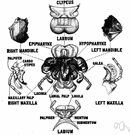clyp·e·us
(klĭp′ē-əs)n. pl. clyp·e·i (-ē-ī′)
A shieldlike plate on the front of the head of an insect.
[New Latin, from Latin clipeus, round shield.]
clyp′e·al (-ē-əl) adj.
American Heritage® Dictionary of the English Language, Fifth Edition. Copyright © 2016 by Houghton Mifflin Harcourt Publishing Company. Published by Houghton Mifflin Harcourt Publishing Company. All rights reserved.
clypeus
(ˈklɪpɪəs)n, pl clypei (ˈklɪpɪˌaɪ)
(Zoology) a cuticular plate on the head of some insects between the labrum and the frons
[C19: from New Latin, from Latin clipeus round shield]
ˈclypeal adj
clypeate adj
Collins English Dictionary – Complete and Unabridged, 12th Edition 2014 © HarperCollins Publishers 1991, 1994, 1998, 2000, 2003, 2006, 2007, 2009, 2011, 2014
clyp•e•us
(ˈklɪp i əs)n., pl. clyp•e•i (ˈklɪp iˌaɪ, -iˌi)
a rounded plate at the front of an insect's head, above the mouthparts.
[1825–35; < New Latin; Latin clypeus, clipeus round shield]
clyp′e•al, adj.
Random House Kernerman Webster's College Dictionary, © 2010 K Dictionaries Ltd. Copyright 2005, 1997, 1991 by Random House, Inc. All rights reserved.
ThesaurusAntonymsRelated WordsSynonymsLegend:
| Noun | 1. |  clypeus - a shield-like plate on the front of an insect's head clypeus - a shield-like plate on the front of an insect's headprotective covering - the tough natural covering of some organisms insect - small air-breathing arthropod |
Based on WordNet 3.0, Farlex clipart collection. © 2003-2012 Princeton University, Farlex Inc.